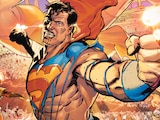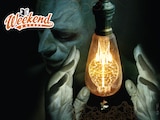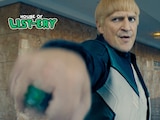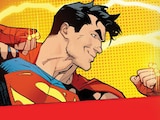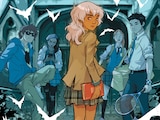Over the course of the week, we’ll be posting interviews with some writers and artists working on DC Comics-The New 52. You’ll get some teases and insights into who these creative teams are and learn about their thoughts on creating comic books and graphic novels.
Up first is MISTER TERRIFIC writer Eric Wallace.
 THE SOURCE: How do you write the first line of a new series?
ERIC WALLACE: I like the first line of dialogue out of a new hero’s mouth to sum up their world in a sentence. That first line should tell us about where a character is and what they’re doing, not just who they are. And that’s the tricky part – finding one opening sentence that can service a lot of masters. It’s tricky. Sometimes I find myself agonizing over an opening sentence for days. However, it was quite the opposite on MISTER TERRIFIC. His first line just popped up and worked. And despite rewriting the script a few times, that first sentenced never changed.
How do you introduce a new hero?
With MISTER TERRIFIC, I’m taking the approach that this will be a whole new audience for the character, that most people won’t have encountered him before. Therefore, everything you need to know about Michael Holt and his world gets introduced in the first three issues, and most of it in issue #1. That includes his origins, which have changed slightly from his appearances in the pre-FLASHPOINT DCU.
Beyond that, I don’t think you have to introduce every single aspect of a hero or character’s personality initially. What I believe is more important is that you showcase the character’s potential, that you show that he or she is more than the sum of the parts presented. That the world she or he inhabits is interesting and exciting enough to warrant a long-term series of stories.
How do you introduce characters?
I think it’s best to introduce a character while they’re in the middle of some action or task, preferably one that clearly defines them. If it’s a hero, then show them doing something heroic. And don’t start in the beginning of a scene. Start in the middle of the action, when the pressure is really on for the hero. This way, you’ll really get to see what kind of person the hero is. That’s how Michael Holt gets introduced in MISTER TERRIFIC #1. He’s dodging high-tech lasers, trying not to get killed.
THE SOURCE: How do you write the first line of a new series?
ERIC WALLACE: I like the first line of dialogue out of a new hero’s mouth to sum up their world in a sentence. That first line should tell us about where a character is and what they’re doing, not just who they are. And that’s the tricky part – finding one opening sentence that can service a lot of masters. It’s tricky. Sometimes I find myself agonizing over an opening sentence for days. However, it was quite the opposite on MISTER TERRIFIC. His first line just popped up and worked. And despite rewriting the script a few times, that first sentenced never changed.
How do you introduce a new hero?
With MISTER TERRIFIC, I’m taking the approach that this will be a whole new audience for the character, that most people won’t have encountered him before. Therefore, everything you need to know about Michael Holt and his world gets introduced in the first three issues, and most of it in issue #1. That includes his origins, which have changed slightly from his appearances in the pre-FLASHPOINT DCU.
Beyond that, I don’t think you have to introduce every single aspect of a hero or character’s personality initially. What I believe is more important is that you showcase the character’s potential, that you show that he or she is more than the sum of the parts presented. That the world she or he inhabits is interesting and exciting enough to warrant a long-term series of stories.
How do you introduce characters?
I think it’s best to introduce a character while they’re in the middle of some action or task, preferably one that clearly defines them. If it’s a hero, then show them doing something heroic. And don’t start in the beginning of a scene. Start in the middle of the action, when the pressure is really on for the hero. This way, you’ll really get to see what kind of person the hero is. That’s how Michael Holt gets introduced in MISTER TERRIFIC #1. He’s dodging high-tech lasers, trying not to get killed.
 How do you draw a first appearance?
I leave a decision like that up to a brilliant artist like Gianluca.
How do you introduce a new villain?
I think it’s important to give a villain an air of menace before they ever appear. Readers will see in MISTER TERRIFIC #1 what the new villain Brainstorm is capable of. But the villain himself doesn’t appear until issue #2. So by the time you meet Brainstorm, you’re already aware of what he can do and how dangerous his abilities might be. That helps create added tension for the reading audience when the hero—in this case, Mister Terrific—finally meets his new adversary.
What was the first comic you ever worked on?
My first comic work was an eight-page Vixen story for the DC HALLOWEEN SPECIAL 2008. As a parent, I wanted to tell a story that would empower young African-American females. So that first Vixen story ends with her telling a young Black girl about the possibilities of the world, and that it’s now possible for a diverse young lady like her to grow up and become anything she wants to be.
What was the first series you collected?
Although I had issues of many other series, AMAZING SPIDER-MAN was the first book I collected in an obsessive and fanatical nature. UNCANNY X-MEN and SWAMP THING were a close second and third.
How do you draw a first appearance?
I leave a decision like that up to a brilliant artist like Gianluca.
How do you introduce a new villain?
I think it’s important to give a villain an air of menace before they ever appear. Readers will see in MISTER TERRIFIC #1 what the new villain Brainstorm is capable of. But the villain himself doesn’t appear until issue #2. So by the time you meet Brainstorm, you’re already aware of what he can do and how dangerous his abilities might be. That helps create added tension for the reading audience when the hero—in this case, Mister Terrific—finally meets his new adversary.
What was the first comic you ever worked on?
My first comic work was an eight-page Vixen story for the DC HALLOWEEN SPECIAL 2008. As a parent, I wanted to tell a story that would empower young African-American females. So that first Vixen story ends with her telling a young Black girl about the possibilities of the world, and that it’s now possible for a diverse young lady like her to grow up and become anything she wants to be.
What was the first series you collected?
Although I had issues of many other series, AMAZING SPIDER-MAN was the first book I collected in an obsessive and fanatical nature. UNCANNY X-MEN and SWAMP THING were a close second and third.
 Who was the first writer you followed?
Alan Moore. No question about it. I followed him from SWAMP THING to a host of other great works like WATCHMEN, FROM HELL, and LEAGUE OF EXTRAORDINARY GENTLEMEN, and continue to follow his work today.
Who was the first artist you followed?
Growing up, I would pick up anything drawn by John Byrne. I remember reading his run on X-MEN and FANTASTIC FOUR. Those runs were seminal. So when he jumped to DC for THE MAN OF STEEL and SUPERMAN, I followed. His work with Clark Kent and company still resonates with me to this day.
What was the first convention you attended as a fan?
My first genre fan event was a DOCTOR WHO convention in 1984, where I got to meet Jon Pertwee, the Third Doctor. Talk about mind-blowing! But ironically, even though I was reading comics at that time, I didn’t attend an official comic book convention until the early 90s. It was probably the monthly Sci-Fi & Comic Conventions that happen here in Los Angeles. They used to hold them at the Shrine Auditorium, which is the same place they used to hold Oscar ceremonies decades earlier.
What was the first convention you attended as a professional?
The San Diego Comic Convention. I first attended SDCC in the mid-to-late 90’s and have been every year since. But it was really weird to attend it for the first time as a professional, which was only about five years ago.
What was the first comic book you read?
RICHIE RICH was my very first comic book memory at age four or five. From there I graduated to ARCHIE and then a lot of the Gold Key books like TUROK, SON OF STONE and DARK SHADOWS.
Who was the first writer you followed?
Alan Moore. No question about it. I followed him from SWAMP THING to a host of other great works like WATCHMEN, FROM HELL, and LEAGUE OF EXTRAORDINARY GENTLEMEN, and continue to follow his work today.
Who was the first artist you followed?
Growing up, I would pick up anything drawn by John Byrne. I remember reading his run on X-MEN and FANTASTIC FOUR. Those runs were seminal. So when he jumped to DC for THE MAN OF STEEL and SUPERMAN, I followed. His work with Clark Kent and company still resonates with me to this day.
What was the first convention you attended as a fan?
My first genre fan event was a DOCTOR WHO convention in 1984, where I got to meet Jon Pertwee, the Third Doctor. Talk about mind-blowing! But ironically, even though I was reading comics at that time, I didn’t attend an official comic book convention until the early 90s. It was probably the monthly Sci-Fi & Comic Conventions that happen here in Los Angeles. They used to hold them at the Shrine Auditorium, which is the same place they used to hold Oscar ceremonies decades earlier.
What was the first convention you attended as a professional?
The San Diego Comic Convention. I first attended SDCC in the mid-to-late 90’s and have been every year since. But it was really weird to attend it for the first time as a professional, which was only about five years ago.
What was the first comic book you read?
RICHIE RICH was my very first comic book memory at age four or five. From there I graduated to ARCHIE and then a lot of the Gold Key books like TUROK, SON OF STONE and DARK SHADOWS.
 What was your first job in the comic book industry?
My first job was “comic book reader.” That might sound silly, but I don’t mean to be flippant or sarcastic. I honestly think the best way to become a comic book writer—or writer of any sort—is to read. Read as much as you can. When it comes to comic books, my job was to read and absorb a ton of quality comic book storytelling so that I could learn the rules, language, and conventions of the medium. Which, of course, makes it easier to break them later on.
What was the first piece of original art you bought?
Honestly, I haven’t bought any yet. Unless you’re counting that KISS poster I spent a month’s allowance on in the fifth grade.
What was the first digital comic book you downloaded?
I believe it was THE AUTHORITY #1. That series was so great. The first issue is a perfect example of how to set up a series and accomplish everything you need to hook an audience in a debut story.
What was your first job in the comic book industry?
My first job was “comic book reader.” That might sound silly, but I don’t mean to be flippant or sarcastic. I honestly think the best way to become a comic book writer—or writer of any sort—is to read. Read as much as you can. When it comes to comic books, my job was to read and absorb a ton of quality comic book storytelling so that I could learn the rules, language, and conventions of the medium. Which, of course, makes it easier to break them later on.
What was the first piece of original art you bought?
Honestly, I haven’t bought any yet. Unless you’re counting that KISS poster I spent a month’s allowance on in the fifth grade.
What was the first digital comic book you downloaded?
I believe it was THE AUTHORITY #1. That series was so great. The first issue is a perfect example of how to set up a series and accomplish everything you need to hook an audience in a debut story.

Editorial
Who’s Who At DC Comics-The New 52: Eric Wallace
BY: David Hyde
Monday, August 15th, 2011
